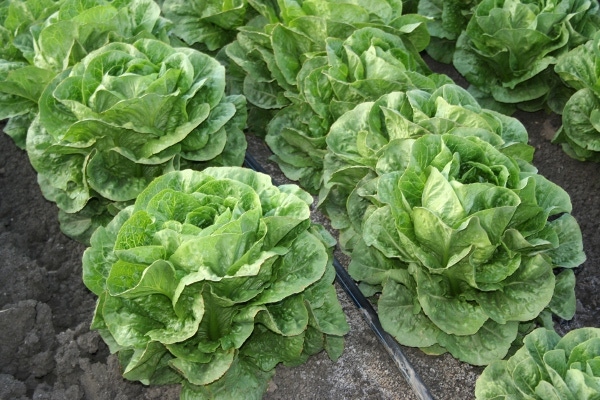February 24, 2011

The latest Arizona Vegetable Integrated Pest Management Update from the University of Arizona (UA) Cooperative Extension in Yuma, Ariz.
Thrips management in desert produce
By John Palumbo, UA Research Scientist and Extension Specialist
With the rain experienced over the Feb. 18 weekend, a decline in thrips numbers on leafy vegetables is likely to occur.
Precipitation amounts varied throughout the Yuma area with the highest recorded AZMET levels recorded in the Gila Valley at 0.46 inch, and the least recorded at the Roll station (0.14 inch). The Yuma Valley received at least 0.40 inch of rainfall on Feb. 19.
However, as experienced last year with much heavier and more frequent rainfall, these declines can be short-lived. Typically, heavy rainfall can dislodge or even drown adult thrips on plants and can suffocate the larvae in the soil if it remains wet for prolonged periods. Once the plants dry, adults can quickly move back onto plants.
Another factor that pest control advisers should be concerned with this time of the year is thrips "bioconcentration"which occurs each year in late February and March as lettuce acreage declines in the low desert due to the end of the season. This is coincident with an increase in thrips abundance that occurs due to higher temperatures.
Each time a lettuce field is harvested and disked adult thrips populations disperse from these areas into the next available lettuce field. As lettuce acres are reduced at the end of the season, this creates a bottleneck effect that concentrates high numbers of thrips adults on the remaining fields under production.
This can often make chemical control very difficult, particularly in March, as thrips may continually re-infest fields following spray applications.
Random notes: Radiant (6-8 ounce/acre) and Lannate (0.75 lb) + pyrethroid (high rate) are providing good residual efficacy of thrips in our trials at the Yuma Ag Center.
Remember, the key to good thrips control is to prevent immature populations from becoming established.
For more information on the identification, biology, ecology, and management of thrips on desert produce, read " Insect Management on Desert Produce Crops: Western Flower Thrips" and "Thrips Management in Desert Leafy Vegetables" .
Contact Palumbo: (928) 928-782-3836 or [email protected].
Downy mildew
Downy mildew
By Mike Matheron, UA Extension Plant Pathologist
Rainfall amounts recorded Feb. 19 were 0.38, 0.46, and 0.14 inches at the Arizona Meteorological Network (AZMET) stations at the Yuma Agricultural Center, North Gila, and Roll locations respectively. High relative humidity levels in the morning exceeding 90 percent were recorded for at least three days following the rainfall event.
These environmental conditions, plus the current presence of lettuce downy mildew in the southwest desert vegetable production region, strongly suggest further development of the disease in the future.
To obtain the highest level of disease containment, fungicide applications should begin before the actual appearance of downy mildew lesions on lettuce plants. There is a lag time between infection by the pathogen (Bremia lactucae) and the appearance of visible symptoms.
This incubation period can range from three days to longer than a week, depending on the temperature, relative humidity, and susceptibility of the lettuce variety. By the time lettuce downy mildew lesions are observed, many more are likely present but have not matured to a sufficient extent to be visible.
Data from trials conducted on lettuce downy mildew for the past two years at the Yuma Agricultural Center demonstrate that disease severity could be reduced from 70 to 86 percent compared to untreated plants with treatment programs containing Acrobat, Aliette, Curzate, Presidio, Previcur Flex, Prophyt, Revus, and Tanos.
If a lettuce downy mildew fungicide trial now in progress is successful, we will have efficacy data for many of the individual compounds that can be used within disease management programs.
This will allow the creation of treatment programs containing the most effective component fungicides which should maximize overall disease control.
For effective resistance management, using compounds with different modes of action within treatment programs is essential.
Contact Matheron: (928) 726-6856 or [email protected].
Herbicides for irrigation ditch banks
Herbicides for irrigation ditch banks
By Barry Tickes, UA Area Agriculture Agent
Weeds are a problem year after year even where diligently controlled. A major reason is that weed seeds continually move into fields by irrigation water, wind, equipment, contaminated seed, and other means.
Controlling weeds on irrigation ditch banks can greatly help reduce weed seed movement into fields.
The Environmental Protection Agency regards “non-crop” areas as those not dedicated to crop production. Although crops are not normally grown on irrigation ditch banks, these areas should not be managed as non-crop.
Several very broad spectrum and long lasting herbicides are registered for “non-crop” areas which include roadsides, industrial sites, fence rows, around structures, and railroads. Irrigation ditch banks should be considered separately due to the proximity to crop fields and irrigation water and the potential for herbicide movement into sensitive areas.
It is important to read the label carefully and only use products specifically allowed for use on “ditch banks.” Some products are restricted to drainage ditch banks or dry ditches. Some can be used only above the water line. Some can only be used for non-irrigation ditch banks. Since most ditches in the Yuma area are used for irrigation, this can be confusing.
The definition of a ditch can include an open trench or natural channel. It can also include ditches not in use for long periods of time.
Some labels specify how long this non-use period should be. Click on this link for a list of the Herbicides Registered For Irrigation Ditch Banks in Arizona. It has those that can only be used on drainage ditches or dry ditches and if the products have soil residual or foliar activity. It does not include several available premixes.
Contact Tickes: (928) 580-9902 or [email protected].
Future meetings
Southwest Ag Summit - March 9-10, 2011.
For more information, call the Yuma County Cooperative Extension Office at 928-726-3904 or go online to http://swagsummit.com/event_schedule.html.
You May Also Like




